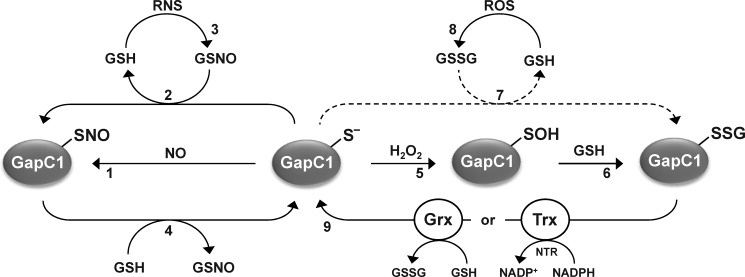FIGURE 10.
Reactions leading to (de)nitrosylation and (de)glutathionylation of AtGAPC1. Reduced AtGAPC1 (GAPC1-S−) undergoes S-nitrosylation in the presence of NO donors (1) or trans-nitrosylation by GSNO with concomitant release of GSH (2). GSNO can be generated by the reaction of GSH with RNS (3). Denitrosylation of nitrosylated GAPC1 (GAPC1-SNO) is not catalyzed by plant cytoplasmic TRXs, but it is efficiently catalyzed by GSH with formation of GSNO (4), hence controlled by the [GSH]/[GSNO] ratio. AtGAPC1 can undergo primary oxidation to sulfenic acid (GAPC1-SOH) in the presence of H2O2 (5) that can subsequently react with GSH leading to the glutathionylated form (GAPC1-SSG) (6). In principle, GAPC1 glutathionylation may also be performed by GSSG with release of GSH (7), but this reaction does not occur under physiological [GSH]/[GSSG] ratios (dashed arrow). GSSG can be formed by the reaction of GSH with ROS (8). Deglutathionylation of GAPC1-SSG can be catalyzed by either TRX system (i.e. TRX plus NADPH and NADPH:thioredoxin reductase (NTR)) or GRX system (GRX plus GSH) (9). Therefore, glutathionylation of GAPC1 is indirectly controlled by either [NADPH]/[NADP+] and/or [GSH]/[GSSG] ratios.

